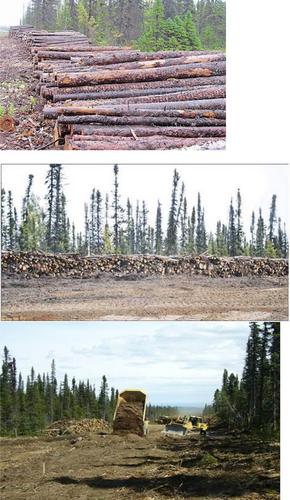当前位置:
X-MOL 学术
›
Food Energy Secur.
›
论文详情
Our official English website, www.x-mol.net, welcomes your feedback! (Note: you will need to create a separate account there.)
Economic feasibility of biochar and agriculture coproduction from Canadian black spruce forest
Food and Energy Security ( IF 5 ) Pub Date : 2019-10-29 , DOI: 10.1002/fes3.188 Catherine Keske 1 , Todd Godfrey 2 , Dana L.K. Hoag 3 , Joinal Abedin 4
Food and Energy Security ( IF 5 ) Pub Date : 2019-10-29 , DOI: 10.1002/fes3.188 Catherine Keske 1 , Todd Godfrey 2 , Dana L.K. Hoag 3 , Joinal Abedin 4
Affiliation

|
This study calculates the economic feasibility of converting biomass from black spruce forests into biochar and using it as soil amendment to grow potatoes (Solanum tuberosum L.) and beets (Beta vulgaris L.) to improve food availability in one of Canada's most consistently food insecure provinces. The trees were clear cut for the construction of the controversial Muskrat Falls hydroelectric dam and have been left to decay due to a lack of economically feasible processing options. A stochastic analysis conducted on a biochar production budget of a slow pyrolysis mobile biochar unit reveals fixed and variable cost estimates of $505.14 Mg−1 and $499.13 Mg−1, respectively. Applying the biochar as a soil amendment for local beet or potato production makes the biochar venture profitable. Beet field trial data from the study region using 10 t C biochar application rates increases beet yield from 2.9 Mg/ha to 11.4 Mg/ha with a midline increase of 5.59 Mg/ha. A stochastic analysis with variable prices and yields shows a 0.99 probability of biochar production being profitable when applied to beets at the midline production rate, with an average annualized net return over variable costs of $4,953 ha−1, and maximum annualized net return of $11,288 ha−1, over variable costs. Potato production yields average annualized net returns of $965.48 ha−1 over variable costs, but with much more downside risk, considering the minimum annualized net return of −$318.82 ha−1 over variable costs. Biochar application covers average total costs for beets but not potatoes. Using biochar from forest biomass as a soil amendment presents an opportunity to create a local market for biochar in a remote area of Canada, where biochar may be used as an experimental soil amendment to improve food security.
中文翻译:

加拿大黑云杉林生物炭和农业联产的经济可行性
这项研究计算了将黑云杉林中的生物质转化为生物炭并将其用作土壤改良剂以种植马铃薯(Solanum tuberosum L.)和甜菜(Beta vulgaris L.)的经济可行性,以改善加拿大最持续存在的粮食不安全状况之一省。这些树木被明确砍伐,用于建设有争议的Muskrat Falls水力发电大坝,由于缺乏经济上可行的加工选择,这些树木已经腐烂。对慢速热解移动生物炭装置的生物炭生产预算进行的随机分析显示,固定成本和可变成本估算分别为$ 505.14 Mg -1和$ 499.13 Mg -1, 分别。将生物炭作为土壤改良剂用于当地甜菜或马铃薯的生产,使该生物炭项目有利可图。使用10 t C生物炭施用量的研究区域的甜菜田间试验数据将甜菜产量从2.9 Mg / ha增加到11.4 Mg / ha,中线增加5.59 Mg / ha。具有可变价格和收益率的随机分析显示,以中线生产率应用于甜菜时,生物炭生产具有0.99概率的获利可能性,可变成本的平均年化净收益为$ 4,953 ha -1,最大年化净收益为$ 11,288 ha -1,超过可变成本。马铃薯生产的平均年化净收益为$ 965.48公顷-1考虑可变成本的最低年化净回报为$ 318.82公顷-1。生物炭的应用覆盖了甜菜的平均总成本,但不包括马铃薯。将来自森林生物质的生物炭用作土壤改良剂,为在加拿大偏远地区建立生物炭本地市场提供了机会,加拿大的生物炭可用作改良土壤安全性的实验性土壤改良剂。
更新日期:2019-10-29
中文翻译:

加拿大黑云杉林生物炭和农业联产的经济可行性
这项研究计算了将黑云杉林中的生物质转化为生物炭并将其用作土壤改良剂以种植马铃薯(Solanum tuberosum L.)和甜菜(Beta vulgaris L.)的经济可行性,以改善加拿大最持续存在的粮食不安全状况之一省。这些树木被明确砍伐,用于建设有争议的Muskrat Falls水力发电大坝,由于缺乏经济上可行的加工选择,这些树木已经腐烂。对慢速热解移动生物炭装置的生物炭生产预算进行的随机分析显示,固定成本和可变成本估算分别为$ 505.14 Mg -1和$ 499.13 Mg -1, 分别。将生物炭作为土壤改良剂用于当地甜菜或马铃薯的生产,使该生物炭项目有利可图。使用10 t C生物炭施用量的研究区域的甜菜田间试验数据将甜菜产量从2.9 Mg / ha增加到11.4 Mg / ha,中线增加5.59 Mg / ha。具有可变价格和收益率的随机分析显示,以中线生产率应用于甜菜时,生物炭生产具有0.99概率的获利可能性,可变成本的平均年化净收益为$ 4,953 ha -1,最大年化净收益为$ 11,288 ha -1,超过可变成本。马铃薯生产的平均年化净收益为$ 965.48公顷-1考虑可变成本的最低年化净回报为$ 318.82公顷-1。生物炭的应用覆盖了甜菜的平均总成本,但不包括马铃薯。将来自森林生物质的生物炭用作土壤改良剂,为在加拿大偏远地区建立生物炭本地市场提供了机会,加拿大的生物炭可用作改良土壤安全性的实验性土壤改良剂。


























 京公网安备 11010802027423号
京公网安备 11010802027423号